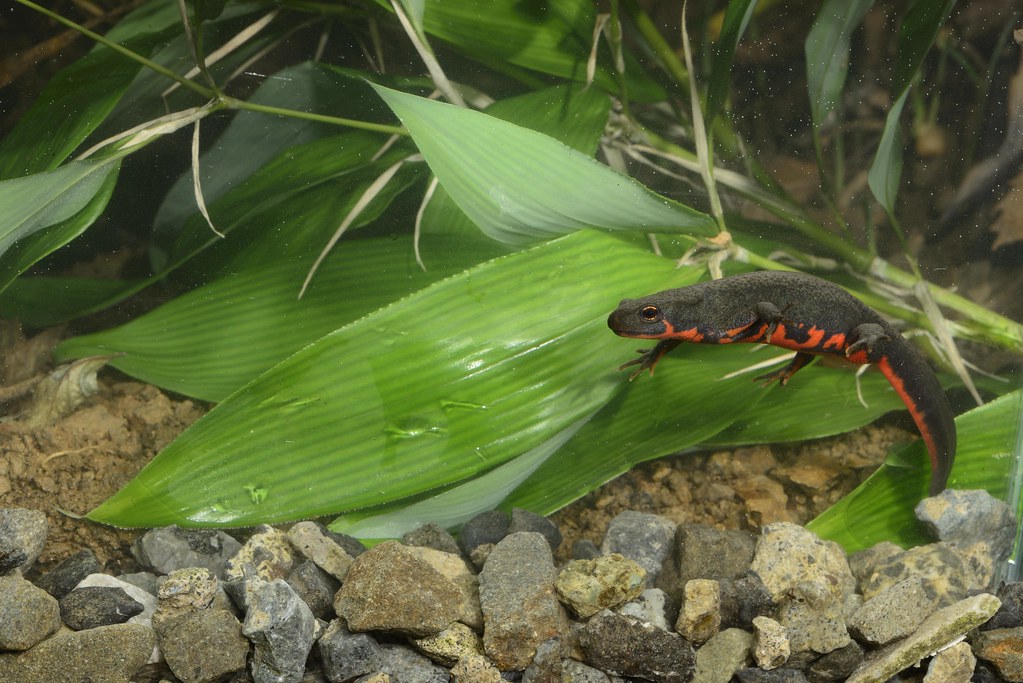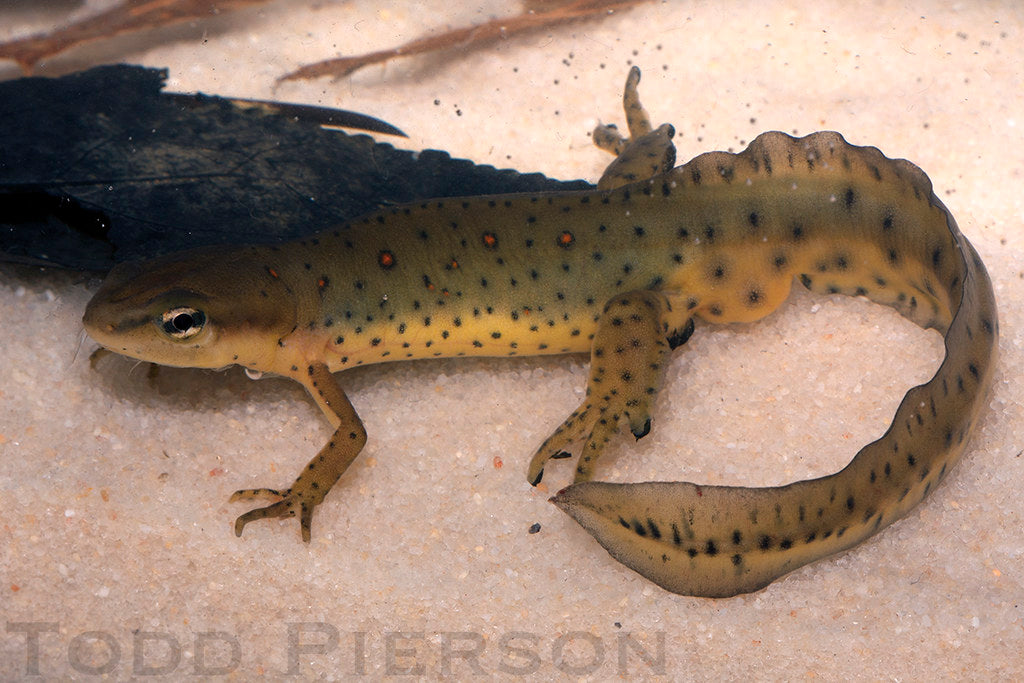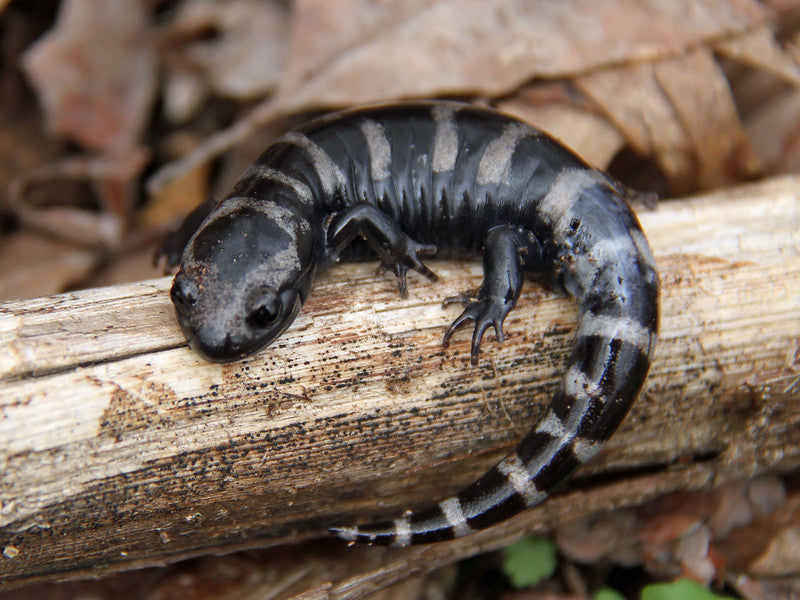Fire belly newts (Cynops pyrrhogaster) are small, semi-aquatic amphibians. They are native to the islands of Japan. They are entirely aquatic as larvae and semiaquatic as adults. Fire belly newts can be found in just about any body of still, clear water in Japan.
Fire belly newts are generally 3.5-5” long as adults, with females being larger. They are a fairly robust newt, with a large head, granular skin, and a dorsal ridge. Coloring is dark brown-black on top with a bright orange to red underside interrupted by white and/or dark markings.
There are actually two types of fire belly newt commonly found in the pet trade: Cynops pyrrhogaster and Cynops orientalis. Although they have essential differences, their care requirements are similar. Either way, fire belly newts are considered beginner-level amphibians due to their relative hardiness. With good care, a pet fire belly newt may live up to 45 years!
How much space do fire belly newts need?
The minimum size for housing up to four fire belly newts is 30”L x 12”W x 12”H, or a long 20 gallon tank. However, larger is preferred. There should be a tightly-fitting lid on top to prevent potential escape.
Do fire belly newts need UVB?
It’s not required for their survival, but it is still best practice to provide UVB lighting for your newt’s optimal health and wellbeing. Providing UVB lighting to your newt gives them all of the vitamin D that their body needs, stimulates better appetite and activity, and generally allows them to be healthier than they would be without.
The best UVB bulb for fire belly newts housed in a 20 gallon enclosure is going to be the Zoo Med Compact Fluorescent Reptisun 5.0, 26w. This bulb should be housed in a reflective fixture like the 12” Zoo Med Naturalistic Terrarium Hood, and placed on top of the mesh lid. UVB is blocked by glass and plastic, so you can’t give your newt UVB by placing the enclosure in front of an open window. UVB bulbs decay over time, so don’t forget to replace your bulb every 6 months to maintain good performance.
If you are growing live plants in your newt’s aquarium, you will also need a 6500K fluorescent or LED grow light to nourish them.
Lights should be on for 12 hours/day.
What temperatures do fire belly newts need?
Fire belly are ectotherms, which means that they rely on the temperature of their environment to help regulate their metabolism and stay healthy. Like fish, the water temperature should be maintained within a certain range. Optimal water temperature for fire belly newts is between 60-73°F.
If you’re keeping your axolotl in a basement or you normally keep your home at cooler temperatures, then this should happen naturally without need for additional equipment. However, if your home tends to be warmer, then you will need help keeping the water cool enough to keep your newts comfortable. You can either decrease the temperature of the entire room with an air conditioner, or you can decrease the temperature of just the water with an aquarium chiller.
Keep track of water temperatures with an aquarium thermometer.
Water maintenance for fire belly newts
It’s important to keep the water in your newt’s aquarium clean in order to keep your pet healthy. Use a low flow aquarium filter designed for fish that prefer stagnant water.
Perform partial water changes (20-30%) once per week. Any water added to the aquarium should be treated with dechlorinator like Zoo Med Reptisafe to prevent harmful chemicals from being introduced to your pet’s habitat, as amphibians are very sensitive to the chemicals in their environment.
Algae buildup should be manually scrubbed off with a brush or magnetic glass scrubber.
What substrate is good for fire belly newts?
Substrate isn’t necessarily required for your newts’ wellbeing, but it’s a good idea to add some to the aquarium to improve the enclosure’s appearance and provide a medium for any live plants to grow in.
Due to the risk of impaction, it’s best to use a substrate that is either too large for your newts to ingest or too small to cause a problem. The best substrate for newts is fine sand such as Exo Terra Riverbed Sand or fluorite. This substrate must be routinely cleaned with a siphon to maintain good hygiene.
What décor can you use in a fire belly newt aquarium?
It’s terribly boring for a newt to be stuck in an enclosure with nothing in it. It doesn’t matter how big the enclosure is if you don’t put things in it for your pet to use and interact with.
At minimum, your newts will require at least one haul-out area to leave the water as needed. This land area should be roughly 30% of the aquarium’s surface area, and can be created either with a floating raft-style basking area for turtles, or by creating an artificial shoreline with soil and plants.
Other décor options for fire belly newts include:
- mopani wood
- cork bark
- rocks
- live or artificial plants
- pre-made hides/caves
- artificial ornaments
Whatever you choose to use, make sure that the newt has cover to hide in so it can feel secure in its environment.
What do fire belly newts eat?
Fire belly newts are primarily carnivores, which means that they need to eat whole animal prey in order to get the nutrition that they need. Over food every other day, as much food as they will eat within ~10 minutes. Clean up any excess at the end to help maintain good water quality.
Food options for fire belly newts:
- Blackworms
- Bloodworms
- Brine shrimp
- Crickets
- Earthworms (chopped)
- Fish
- Ghost shrimp
- Glassworms
- Tubifex worms
- Salamander pellets
Certain commercial diets such as Omega One Newt & Salamander Pellets and Hikari Sinking Carnivore Pellets are a good idea to include in your newt’s diet because they will help ensure that your pet is getting enough vitamins and minerals.
Can fire belly newts be handled?
Very few amphibians can be handled regularly, and given that fire belly newts are slightly toxic and semiaquatic, it’s best to treat them like fish and keep your hands off this pet.
*This care sheet contains only very basic information. Although it’s a good introduction, please do further research with high-quality sources to obtain additional information on caring for this species.
"Cynops pyrrhogaster" by sebastian.voitel is licensed under CC BY-NC-SA 2.0




Leave a comment
This site is protected by hCaptcha and the hCaptcha Privacy Policy and Terms of Service apply.